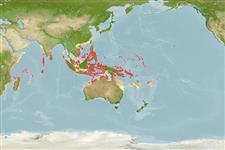Actinopterygii (ray-finned fishes) >
Perciformes (Perch-likes) >
Lethrinidae (Emperors or scavengers) > Lethrininae
Etymology: Lethrinus: Greek, lethrinia, a fish pertaining to genus Pagellus. More on author: Valenciennes.
Environment / Climate / Range
Ecology
Marine; reef-associated; non-migratory; depth range 2 - 25 m (Ref. 9710). Tropical, preferred ?; 25°N - 26°S, 32°E - 173°W
Indo-West Pacific: Tanzania and Mozambique to Papua New Guinea, Palau, and Caroline Islands. Recently reported from the Penghu Islands (Ref. 55073).
Size / Weight / Age
Maturity: Lm ? range ? - ? cm
Max length : 50.0 cm TL male/unsexed; (Ref. 2295); common length : 30.0 cm TL male/unsexed; (Ref. 2295)
Dorsal
spines
(total): 10;
Dorsal
soft rays
(total): 9;
Anal
spines: 3;
Anal
soft rays: 8. The caudal fin is only slightly forked with the tips rounded. The inner surface of the pectoral fin is densely scaled; the posterior angle of the operculum is fully scaled. The head and body is brown or rust red, becoming lighter ventrally. Sometimes there are two light bars on the peduncle. A broad white streak originates from the eye and ends at the tip of the snout. The lips and the base of the pectoral fin are red. The fins are reddish, often bright red or orange.
Occurs over coral reefs and adjacent sandy areas. May be solitary or in small groups. Feeds on echinoderms, mollusks, crustaceans, and small fish. Also caught with handlines (Ref. 9775). Marketed fresh (Ref. 9775).
Life cycle and mating behavior
Maturity | Reproduction | Spawning | Eggs | Fecundity | Larvae
Carpenter, K.E. and G.R. Allen, 1989. FAO Species Catalogue. Vol. 9. Emperor fishes and large-eye breams of the world (family Lethrinidae). An annotated and illustrated catalogue of lethrinid species known to date. FAO Fish. Synop. 125(9):118 p. Rome: FAO. (Ref. 2295)
IUCN Red List Status (Ref. 115185)
CITES (Ref. 94142)
Not Evaluated
Threat to humans
Harmless
Human uses
Fisheries: minor commercial
More information
Common namesSynonymsMetabolismPredatorsEcotoxicologyReproductionMaturitySpawningFecundityEggsEgg development
ReferencesAquacultureAquaculture profileStrainsGeneticsAllele frequenciesHeritabilityDiseasesProcessingMass conversion
Tools
Special reports
Download XML
Internet sources
Estimates of some properties based on models
Phylogenetic diversity index (Ref.
82805): PD
50 = 0.5000 [Uniqueness, from 0.5 = low to 2.0 = high].
Bayesian length-weight: a=0.01995 (0.01140 - 0.03492), b=3.10 (2.95 - 3.25), in cm Total Length, based on LWR estimates for this species & Genus-body shape (Ref.
93245).
Trophic Level (Ref.
69278): 3.7 ±0.51 se; Based on food items.
Resilience (Ref.
69278): Medium, minimum population doubling time 1.4 - 4.4 years (Preliminary K or Fecundity.).
Vulnerability (Ref.
59153): Moderate vulnerability (37 of 100) .
